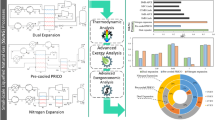Liquefied natural gas (LNG) is an economical form of storage and transportation of natural gas. The demand for LNG is increasing steadily and the infrastructure for its supply is developing as the LNG market expands. This paper reviews the LNG production technologies in terms of their production capacity. The main LNG production volumes (85–90%) are concentrated at large-capacity plants located in coastal areas or at floating plants. In current conditions, new strategies are needed for implementing LNG projects based on medium- and small-capacity plants that can better meet new market demand. Through construction of several lines, they can achieve the production volumes of large-capacity projects. Medium- and small-capacity LNG plants mean modularity, factory assembly, shorter plant construction time, and possibility of development of marginal wells and alternative sources of methane-containing gas. The main advantage of LNG is the possibility of recovering up to 40% of the energy spent on liquefaction during the regasification process. Natural gas contains small amounts of heavy inert gases, which are enriched during the liquefaction process. The development of a technology for extracting Kr and Xe from natural gas is a promising area of further research.








Similar content being viewed by others
References
V. L. Bondarenko and T. V. Diachenko, “Utilization of LNG energy. Main directions,” Chem. Petrol. Eng., 56, 247–254 (2020).
E. B. Feodorova, Present State and Development of Global Liquefied Natural Gas Industry: Technology and Equipment [in Russian], RGU Nefti i Gaza imeni I. M. Gubkina, Moscow (2011), p. 159.
A. Klimentyev, T. Mitrova, A. Sobko, et al., Medium-Tonnage LNG in Russia: between the Sky and the Ground [in Russian], Skolkovo, Russia, December 2018, p. 102.
B. S. Rachevskii, “Technoeconomic appraisal of liquefied natural gas production and utilization projects,” Vesti Gazvoi Nauki, No. 2 (34), 225–223 (2018).
A. Yu. Baranov, K. A. Tikhonov, A. M. Andreyev, et al., “Energy efficient natural gas liquefaction cycles,” Nauchn. Zh. NIU ITMO, Ser. Kholodiln. Tekhn. Konditsionirovanie, No. 1, 1–8 (2016).
E. Yu. Biletskii and A. A. Singurov, “Refrigeration cycle on mixed refrigerants in natural gas liquefaction,” Gaz. Prom., No. 3 (798), 68–74 (2020).
O. B. Braginskii, Liquefied Natural Gas: A New Factor of Global Energy Market [in Russian], Moscow (2006), p. 75.
Global Liquefied Gas Market: An Awakened Giant [in Russian]; Access mode: https://www.dw.com/ru/mirovoi-rynokszhizhennogo-gaza-prosnuvshiisya/gigant/a-47735120.
S. A. McIntosh, P. G. Noble, J. Rockwell, and C. D. Ramlakhan, “Moving natural gas across oceans,” Oilfield Review, 20 (2), 50–63 (2008); Russian translation: “Marine transportation of natural gas,” (Summer, 2008), pp. 58–73.
A. M. Arkharov, V. Yu. Semenov, and N. I. Likhacheva, “Investigation of efficient small-capacity natural gas liquefaction plants,” Inzh. Zh.: Nauka i Innovatsii, No. 4, 1–11 (2017).
A. Klimentyev, T. Mitrova, A. Sobko, et al., Possibilities and Prospects of Low-capacity LNG Development in Russia [in Russian], Skolkovo, Russia (July 2018), p. 188.
V. L. Bondarenko, I. A. Losyakov, and O. V. Diachenko, “Krypton and xenon market. Economic aspects of technology of kryptonxenon mixture processing,” Tekhn. Gazy, No. 5, 32–45 (2017).
Author information
Authors and Affiliations
Corresponding author
Additional information
Translated from Khimicheskoe i Neftegazovoe Mashinostroenie, Vol. 57, No. 12, pp. 3–9, December, 2021.
Rights and permissions
About this article
Cite this article
Bondarenko, V.L., Diachenko, O.V. & Diachenko, T.V. Analysis of Industrial LNG Production Technologies. Chem Petrol Eng 57, 985–996 (2022). https://doi.org/10.1007/s10556-022-01036-w
Published:
Issue Date:
DOI: https://doi.org/10.1007/s10556-022-01036-w




